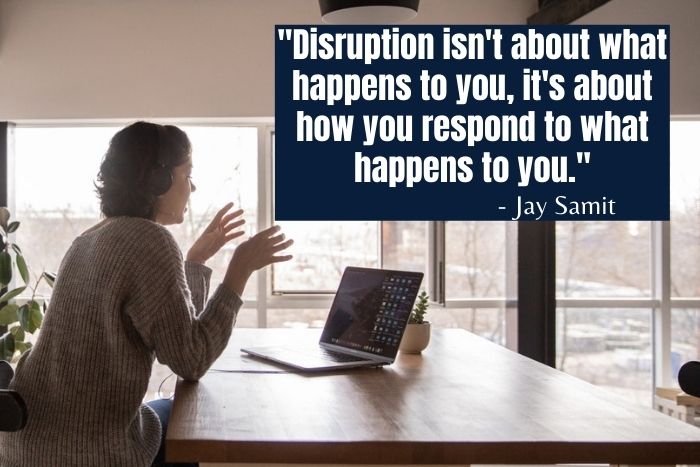How to Help Your Team Manage Disruptions When Working from Home

This is a guest post from Jori Hamiltion (see her bio at the end of the article).
The modern workplace is filled with a myriad of distractions — especially when you’re working remotely.
On the one hand, phones can buzz, emails arrive every few minutes, WiFi signals can come and go, and notifications can ping you from nearly every digital device you own. On the other hand, if you and your employees are working from home, children can shout, dogs can bark, and well-meaning significant others can regularly disturb the peace and focus of your office’s inner sanctum.
If you find that your team is struggling with disruptions as they weather the work-from-home storm of the coronavirus, take steps to address the situation. Here are a few suggestions for how you can help your employees identify and manage disruptions to reestablish productivity, even in a virtual work environment.
Start with Understanding
If you want to manage remote-work disruptions, the first step should be establishing a culture of understanding and diversity within your workforce.
For instance, remote work is an ideal setting for many who are living with a disability. It allows them to work while also balancing things like medical appointments or the need to get extra rest, such as is the case with a hyperthyroid diagnosis. A good manager can help by demonstrating a deep level of understanding in these scenarios. They can even strive to express the perspective that they understand these are important elements of self-care that shouldn’t even be seen as “disruptions” in the first place.
Age differences is another excellent example of how demonstrating understanding can make a difference. If you hire a Millennial parent with kids, a youthful member of Generation Z, and an almost-retired, empty-nesting Baby Boomer, you may find that the Millennial’s child disrupting a video conference rankles the other members of your team. Another age-related scenario could consist of an older member of your staff struggling to adapt to a certain piece of technology, to the chagrin of the younger employees who are ready and waiting.
In frustrating and stressful scenarios like these, leaders should demonstrate an attitude of understanding and empathy for the differences amongst their remote staff members. This will encourage reflective behavior from your employees. It can also foster a social, teamwork-focused environment that maintains a human element rather than a strictly pragmatic, technology-driven atmosphere.
Minimize Potential Disruptions
While training your staff to handle disruptions is an important part of the process, it doesn’t mean the disruptions themselves should be left to occur unchecked. Wise managers and project leaders should step up and do their best to proactively minimize potential disruptions throughout the virtual workspace.
For instance, you should always create company guidelines for remote work operations. Every application that your team uses should be chosen wisely and thoroughly explained. Whether you’re talking about choosing between Zoom and Skype for video chats, opting for email or Slack for important conversations, or using Trello or Asana for collaborative workflow, every tool in your virtual workplace should be clearly defined.
Additionally, make sure to provide adequate training for your staff to use their virtual tools. Use live videos to conduct training and tutorials. If you want to minimize the distractions even further, prerecord the training and upload it as a video for your employees to refer to in the future as well.
By actively setting up a stable remote work structure, you can ensure that your employees know how to operate as they communicate and collaborate regularly.
Encourage Healthy Remote Work Habits
Finally, once you’ve minimized potential distractions and cultivated a culture of diversity and understanding, the last thing that you can do is encourage your employees to further develop their own ability to work through distractions. There are many ways that you can coach your staff to flourish in a remote scenario, including:
Getting organized: An organized and decluttered workspace can do wonders in promoting focus and attention to detail.
Establishing a dedicated workspace: Setting up boundaries via a dedicated workspace enables employees to shift in and out of a work mindset, even at home.
Taking breaks: If distractions abound, gentle encouragement to take a break can allow an employee to tap out and regroup their thoughts.
Promoting healthy habits like these can help employees own their remote work scenarios positively and productively.
Mastering Productivity Despite Disruptions
When done correctly, working from home and even hosting remote work events can be extremely successful. However, a huge key to that success lies in the ability to minimize, understand, and work with the potential distractions that might arise.
You can overcome distractions through workplace culture, minimizing disruptions, and encouraging healthy habits in your staff. This will not only free up your productivity. It will also ensure that you maintain a sense of camaraderie and togetherness even when your team is working from a dozen different places at once.
Jori Hamilton is an experienced writer residing in the Northwestern U.S. She covers a wide range of subjects but takes a particular interest in covering topics related to business productivity, marketing strategies, and HR solutions. To learn more about Jori, you can follow her on Twitter and LinkedIn.
Shawn Kinkade Kansas City Business Coach
